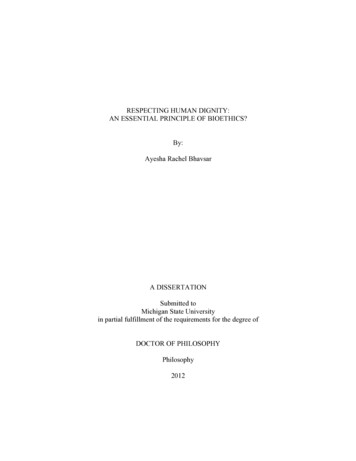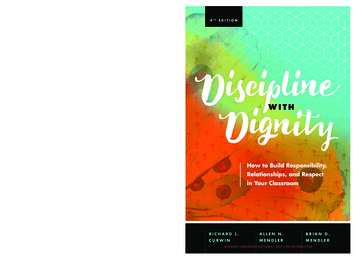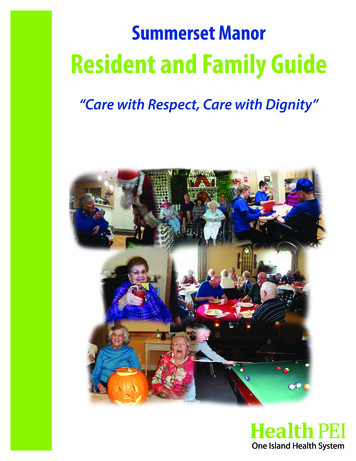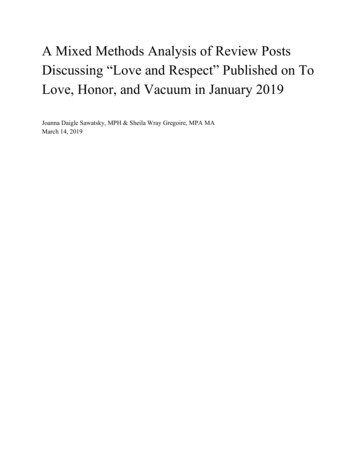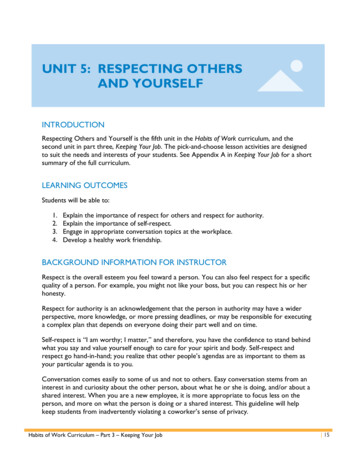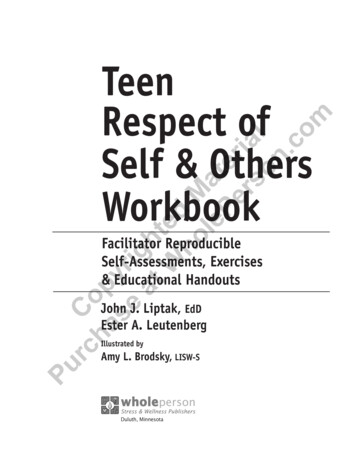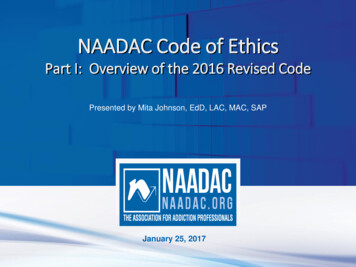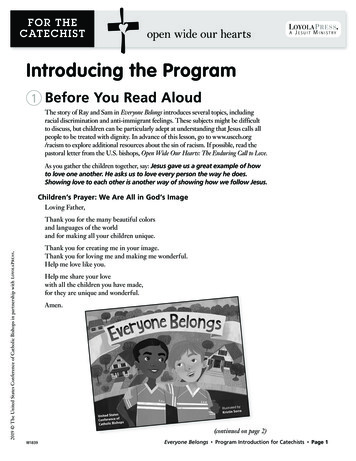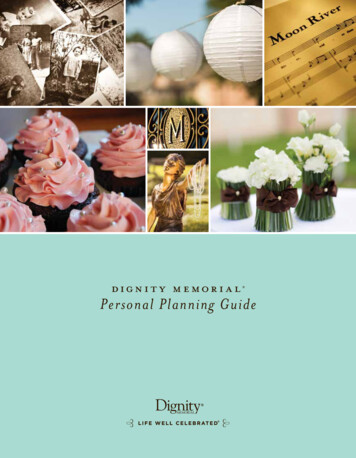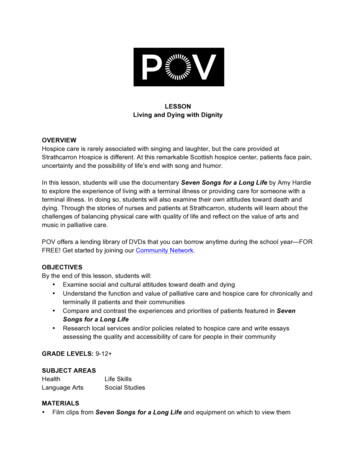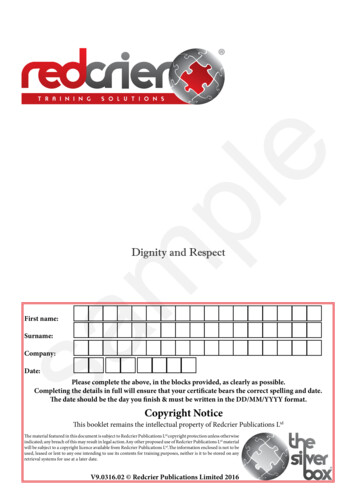
Transcription
emplDignity and RespectsaFirst name:Surname:Company:Date:Please complete the above, in the blocks provided, as clearly as possible.Completing the details in full will ensure that your certificate bears the correct spelling and date.The date should be the day you finish & must be written in the DD/MM/YYYY format.Copyright NoticeThis booklet remains the intellectual property of Redcrier Publications LtdThe material featured in this document is subject to Redcrier Publications Ltd copyright protection unless otherwiseindicated; any breach of this may result in legal action.Any other proposed use of Redcrier Publications Ltd materialwill be subject to a copyright licence available from Redcrier Publications Ltd.The information enclosed is not to beused, leased or lent to any one intending to use its contents for training purposes, neither is it to be stored on anyretrieval systems for use at a later date.V9.0316.02 Redcrier Publications Limited 2016
Dignity and RespectContentsPage 2Page 3Pages 3 - 4Page 5Page 5Unit One.Defining dignity and respect.Unit One Questions.Pages 6 - 10Page 11Pages 12 - 16mplUnit Two.Barriers to providing dignity and respect.Unit Two Questions.eIndex.Learning outcomes.Fundamental standards.Introduction.The common core principles of dignity.Page 17Unit Three.Good practice in promoting dignity and respect.Unit Three Questions.Pages 18 - 25Unit Four.The dignity challenge.Unit Four Questions.Pages 27 - 32Page 26Page 33saN.B: We are aware that official practice is to use the terms “service users” or“people using this service” to describe those receiving care. We prefer the term“client” and use it throughout our training package.Key:worksheet2important
Dignity and RespectLearning outcomes. Understand how the people you support might feel when they are not treated with dignityand respect.Identify best practice when providing services with dignity and respect.Recognise why inappropriate staff attitudes and practices must be challenged.Understand the ten key aspects of the Dept of Health’s Dignity Challenge.Fundamental standards.eThe fundamental standards are the standards by which CQC will inspect social care. Thestandards are based on the regulations from the Care Act 2014 and CQC have changed thefocus for the purposes of inspection.The fundamental standards are those standards that no care setting must fall below.mplThe standards are based on five areas as follows:People are protected from abuse and avoidable harm.Effective.People’s care, treatment and support show quality of life and promotegood outcomes, and providers should show evidence to prove it.Caring.Care should be person centred involving dignity and respect, andcompassion.Responsive.Following correct working procedures as agreed by your workplaceand as set out in the client’s care plan.Well led.Management leadership and governance should ensure all of theabove happens. Staff training should be recognised and opennessand fairness be apparent.saSafe.These areas are known as key lines of enquiry or KLOES. Each KLOE has a set of criteriawhich CQC use to check whether the fundamental standards are being met.3
Dignity and RespectThe fundamental standards are as follows:Person centred care. Ensuring that those receiving the care are at the centre of all decisions.Providing the client with dignity and respect in all aspects of their care.Need for consent.Asking the client’s permission before carrying out tasks that affectthem.Safe care andtreatment.Following correct working procedures as agreed by your workplaceand the client’s care plan.eDignity and respect.Safeguarding service Following agreed working and safeguarding procedures and beingusers from abuse.aware of signs and symptoms.Being aware of dietary needs, working with the care plan, ensuringclients have the right equipment and conditions to eat.Cleanliness, safetyand suitabilityof premises andequipment.Carrying out required checks of premises and equipment, implementingcleaning rotas and carrying out safety checks.mplMeeting nutritionalneeds.Receiving and acting Having a complaints policy and procedure in place that is accessible toon complaints.all and act in accordance with the policy when dealing with complaints.Ensuring that all aspects of the workplace is overseen and policiesand procedures are implemented and monitored regularly.Staffing.Fit and proper persons employed.Fit and proper person requirement for Directors is followed.Duty of candour.Relevant information must be volunteered to all persons who have ormay have been harmed by the provision of services, whether or notthe information has been requested and whether or not a complaintor a report about that provision has been made.saGood governance.Our Redcrier manuals will provide your staff with training to support attainment of thefundamental standards.4
Dignity and RespectIntroduction.Dignity and respect are key factors in ensuring good practice underpins all aspects of your workand life in general. Dignity has become an important part of current government policy andunderpins the regulations outlined by the Care Quality Commissions (CQC).This manual aims to give you an overview of the importance of dignity and respect and how youcan ensure you apply them in all of your dealings with others.The common core principles of dignity:ePrinciple 1: Value the uniqueness of every individual.Principle 2: Uphold the responsibility to shape care services around each individual.Principle 3: Value communicating with individuals in ways that are meaningful to them.mplPrinciple 4: Recognise and respect how an individual’s dignity may be affected whensupported with their personal care.Principle 5: Recognise that an individual’s surroundings and environments are important totheir sense of dignity.Principle 6: Value workplace cultures that actively promote the dignity of everybody.saPrinciple 7: Recognise the need to challenge care that may reduce the dignity of theindividual.5
Dignity and RespectUnit OneDefining dignity and respect.Dignity can be a difficult term to define because it can mean different things to different people.In essence it is the result of being treated with respect. For most of us, dignity is having anotherperson acknowledge and respect the things that matter most to us even though it may meanlittle to them. Respect can be seen as an extension of dignity and can be both given andreceived and is generally built up over time.mplEmpathy.eThe recognition that dignity is not always seen to go hand in hand with providing care for others,has identified the need for change in the way we deliver care to provide a more person centredapproach promoting caring for individual need and in doing so showing dignity and respect forthat individual. This is a basic human right for everyone.In providing dignity and respect it is helpful if we can develop empathy. Empathy is the ability tounderstand and share the feelings of others enabling us to identify with them. Thinking abouthow you would feel if you were in their situation will help you to see the situation from a differentview point.Human Rights Act 1998.Human rights are the basic rights and freedoms that belong to every person in the world. In1948 the United Nations adopted the Universal declaration of human rights, which recognisedthat all human beings have basic rights and freedoms. Non discrimination, equality and fairnessformed the basis of the declaration. From this declaration the convention for the protection ofhuman and fundamental freedoms was born and is monitored by the Council of Europe. In theUk The Human Rights Act 1998 is an interpretation of this convention.saThere are five factors arising from the Human Rights Act and these underpin the person centredapproach. Fairness.Equality.Respect.Dignity.Independence.The following rights are particularly relevant to those receiving a care service.6
Dignity and RespectThe right to a life.Individuals have the right to have their life protected by law. This means, following proceduresto prevent infection, protecting clients from being abused, ensuring that medications areadministered correctly to them.The right to respect for their private life and family life.Everyone is entitled to live their life as they would like without intrusion into their home, includingbeing entitled to privacy and the right to confidential information remaining confidential.eFreedom of thought, conscience and religion.mplEveryone is entitled to hold a belief, or belong to a religion and have it respected. In a caresituation, this may affect times that care is carried out, provision of food and delivery of personalcare.Freedom of expression.Everyone is entitled to an opinion and should be able to express those opinions. In a caresituation, care staff should listen and act on these opinions.The right not to be discriminated against.Everyone is entitled not to be treated differently to others on the grounds defined in the EqualityAct 2010 as protected characteristics eg, race, religion, disability, age etc.Other relevant legislation.Equality Act 2010.saThis act protects people from being discriminated against on the grounds of the 9 protectedcharacteristics including race, religion, gender etc. More information is available in our Equality,diversity and inclusion manual.Mental Capacity Act 2005.This act provides a framework to protect people who are unable to make their own decisionsabout their life. The act assumes that everyone has capacity unless it is proven otherwise. Anydecisions made on behalf of a person defined as lacking capacity must be in the interests ofthat person and the decision should be the least restrictive option. More information is availablein our Mental Capacity Act and Deprivation of Liberty manual.7
Dignity and RespectMental Health Act 1983 (amended 2007).This act makes provision for a person to be detained in hospital for assessment or treatmentwithout the persons’ consent providing certain conditions have been met and it is in the interestof the persons’ health and safety or for the protection of others.Freedom of Information Act 2000.Data Protection Act 1998.eThis act creates a public right of access to ask any public sector organisation for all the recordedinformation they have on any subject. If you ask for information about yourself it will be handledunder the Data Protection Act.mplThis act controls how our personal information is used by organisations, businesses or thegovernment. Everyone who uses data must follow a set of principles to ensure safe handling,use and storage.The Care Act 2014.The Care Act aims to build on good practice in statute as well as embedding new reforms toprovide clearer and fairer care and support to those who need it, rather than just focusing onthose with eligible needs and those who are state funded. It should provide for a more personcentred approach in social care as well as putting a greater focus on prevention and wellbeing.Local authorities will have a wider brief to ensure all of this happens in their local area.The Care Act aims to put people firmly in control of their own care and support. This will help toimprove independence and wellbeing and ensure all aspects of a person’s life are supported.saLocal authorities will be expected to provide access to a variety of services to prevent peopleneeding ongoing care and support. Criteria for assessment of eligibility will be clearer andmore accessible for those needing it. Local authorities will also need to ensure there are a widevariety of care provisions and services and that information advice and advocacy are availableas needed.The principle of wellbeing underpins the Act and should be considered in all decision making.Safeguarding.A new statutory framework for safeguarding protects adults from abuse and neglect. Localauthorities have set up local safeguarding boards in their areas and are responsible forensuring the framework is in place. This is the first time there has been legislation specificallyfor safeguarding adults.8
Dignity and RespectThere are six principles of rotectionPartnershipsAccountability Acting before abuse or neglect happensPerson led decisions and informed consent.Least intrusive response to the risk.Providing support and advocacy where needed.Services working in the local area working togetherBeing transparent in all delivery of safeguarding practices.eA duty of candour has been placed on all providers ensuring they are open and honest in all oftheir dealings with their clients.mplAlthough all of these Acts set out the law on providing dignity and respect, it is up to us asindividuals providing care to others to look at our own practice and how we provide dignity andrespect to each of our clients individually.How do people feel if they have NOT been treated with dignity and respect.Some of the emotions can be very strong and may include being: werless.Angry.saTheir feelings about the staff who have not treated them with dignity and respect can range frombeing disappointed in them and feeling angry to feeling let down and betrayed. This may leadus to think that we should treat people as we would like to be treated, but is this really lookingat the person as an individual.Think about your best friend or a colleague you work regularly with, there may be lots of thingsyou have in common, but think a bit deeper, what are the things that make them different to you.Maybe they prefer tea where you prefer coffee, or perhaps when they are feeling upset, theyprefer to be left alone to think before they talk about it, where as if it was you, you may want totalk about it straight away. Understanding these differences enables you to respect their wishesand make them feel valued.9
Dignity and RespectmpleMake a list of some of the differences between you and your friend or colleague.saNow ask them how they would feel if you ignored these differences and treated them asyou would like to be treated.This exercise shows that in recognising the person as an individual you are able to respecttheir differences and that if you ignore those differences it has a negative effect on the person.It is important to remember that in order to give people the dignity and respect they deservewe need to communicate with them, to listen and hear what they are saying and show anunderstanding of their needs.10
Dignity and RespectUnit One Questions1. Name two factors arising from the Human Rights Act that underpin the personcentred approach.1.2.e2. Name one of the rights from the Human Rights Act that is particularly relevant tothose receiving a care service.mpl3. What does the mental capacity act assume?4. Identify three emotions a client may feel if they are not treated with dignity andrespect.1.2.3.sa5. How might a client feel about a member of staff who has not treated them withrespect.11
Principle 1: Value the uniqueness of every individual. Principle 2: Uphold the responsibility to shape care services around each individual. Principle 3: Value communicating with individuals in ways that are meaningful to them. Principle 4: Recognise and respect how an individual’s dignity
